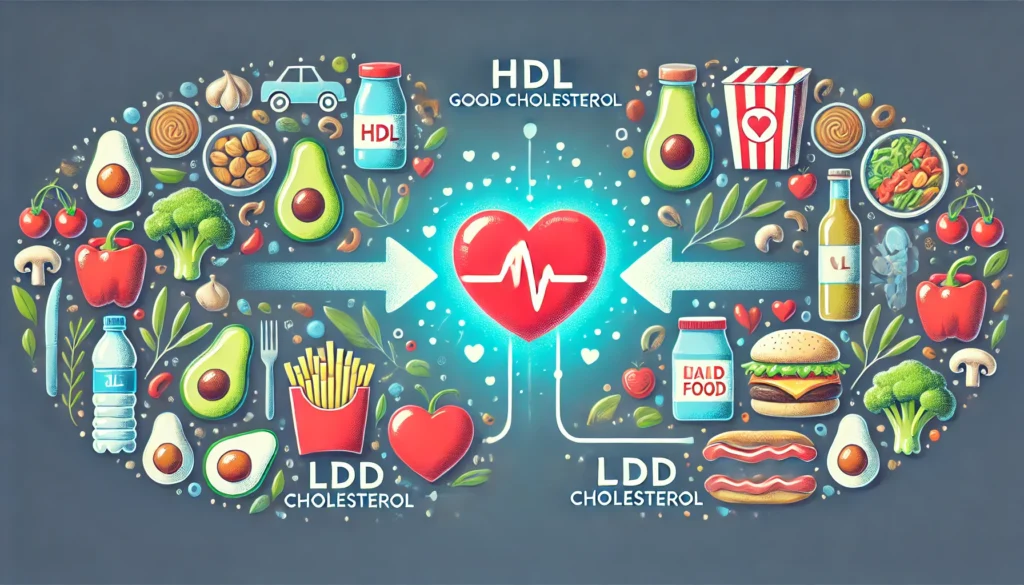Cholesterol often gets a bad rap, but not all cholesterol is created equal. High-density lipoprotein (HDL) and low-density lipoprotein (LDL) play very different roles in your health. A 2024 study by the American Heart Association found that 40% of adults have unhealthy cholesterol levels, increasing their risk of heart disease and stroke. Here’s what you need to know about HDL and LDL—and how to keep your levels in check.
What Are HDL and LDL?
HDL (The “Good” Cholesterol)
- Role: Transports excess cholesterol to the liver for removal.
- Benefits: Protects against heart disease by preventing plaque buildup in arteries.
- Healthy Level: 60 mg/dL or higher.
LDL (The “Bad” Cholesterol)
- Role: Carries cholesterol to your arteries, where it can form plaque.
- Risks: High LDL levels increase the risk of heart disease and stroke.
- Healthy Level: Less than 100 mg/dL.
Why Cholesterol Balance Matters
Health Risks of Imbalance
- High LDL: Leads to plaque buildup, narrowing arteries and restricting blood flow.
- Low HDL: Reduces your body’s ability to remove excess cholesterol.
- Combined Effect: Increases the risk of heart attack, stroke, and peripheral artery disease.
Beyond the Heart
- Brain Health: High LDL is linked to a higher risk of dementia.
- Inflammation: Imbalanced cholesterol levels can trigger chronic inflammation.
How to Improve Your Cholesterol Levels
Dietary Changes
- Increase HDL:
- Eat healthy fats: Avocados, nuts, seeds, and olive oil.
- Add omega-3s: Fatty fish like salmon, mackerel, and sardines.
- Choose whole grains: Oats, quinoa, and brown rice.
- Lower LDL:
- Avoid trans fats: Found in fried and processed foods.
- Limit saturated fats: Reduce red meat, butter, and full-fat dairy.
- Add soluble fiber: Beans, lentils, apples, and flaxseeds.
Lifestyle Adjustments
- Exercise Regularly: Aim for 30 minutes of moderate activity, 5 days a week.
- Quit Smoking: Smoking lowers HDL and damages blood vessels.
- Maintain a Healthy Weight: Excess weight can raise LDL and lower HDL.
Medical Interventions
- Statins: Prescribed to lower LDL levels.
- Niacin: Can raise HDL, but consult a doctor before use.
- Regular Checkups: Monitor cholesterol levels annually if you’re at risk.
Tools to Track and Manage Cholesterol
| Tool | Purpose | Why It’s Useful |
|---|---|---|
| MyFitnessPal | Track diet and cholesterol-friendly foods | Helps you make healthier choices. |
| Cholesterol Tracker | Monitor levels | Provides insights and tips for improvement. |
| Fitbit | Track exercise and heart health | Encourages physical activity to boost HDL. |
Expert Insights: Cholesterol and Health
“HDL is like a garbage truck—it picks up excess cholesterol and takes it away. LDL, on the other hand, is like a delivery truck that drops cholesterol where it shouldn’t be.”
– Dr. Steven Nissen, Cardiologist at the Cleveland Clinic.
“Small changes in diet and lifestyle can have a big impact on your cholesterol levels and overall heart health.”
– Dr. Elizabeth Klodas, Cardiologist and Founder of Step One Foods.
Real-Life Benefits of Balanced Cholesterol
1. Heart Health
Balanced cholesterol reduces the risk of heart disease and stroke.
2. Better Energy
Improved blood flow boosts energy and reduces fatigue.
3. Longer Life
Healthy cholesterol levels are linked to a longer, healthier life.
See also The Power of Intermittent Fasting: A Guide to Better Health and Longevity
The Bottom Line
Understanding the difference between HDL and LDL is key to protecting your heart and overall health. By making smart dietary choices, staying active, and monitoring your levels, you can keep your cholesterol in check and enjoy a healthier, more vibrant life.



